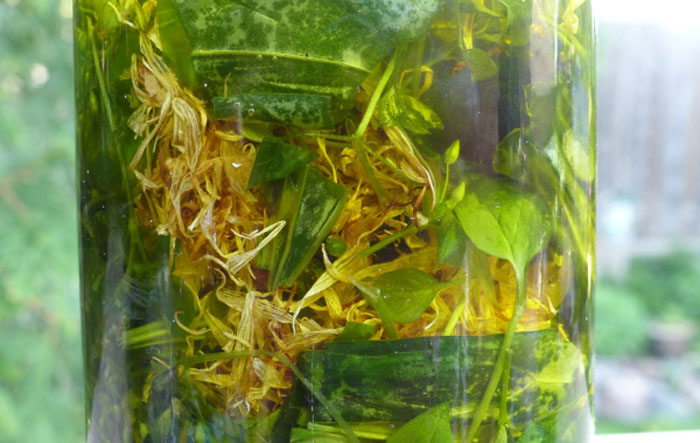
Salves are effective ointments that are very simple to make and the ingredients you need can fit into any budget. These homemade ointments are an amazing addition to your herbal first aid kit and you can make some in easy-to-travel containers.
Making salves can be specifically crafted for a wide variety of purposes. One of the ingredients is beeswax which offers nourishing benefits including soothing, protective, and healing properties. Commonly made salves are for skin ailments. Some common plants used to make salves include:
Burdock root – Great for skin infections.
Calendula flowers – This is suitable for those with sensitive skin. It has strong healing properties used to help skin irritations and skin conditions such as rashes, cuts, scrapes, abrasions, and insect bites.
Chickweed – Soothes minor burns and other skin irritations.
Plantain leaves – This is powerful in the relief and recovery process of insect bites, stings, poison ivy, severe dry skin, blisters, as well as minor sores.
St. John’s Wort flowers – Soothes sunburns, burns and is also used as an anti-inflammatory. In addition it helps to relieve sore muscles, nerve trauma and pain due to varicose veins.
Plantain and chickweed combined make an incredibly healing salve to have in an herbal first aid kit. These two plants with calendula flowers create a powerful healing salve for skin ailments. The image above shows plantain, chickweed and calendula infusing.
Carrier Oils
The least expensive oil of choice is extra virgin olive oil. However, if it is within your budget carrier oils such as almond, avocado and grapeseed oil are great choices. Always make note of the best before date of the oil you choose to use; this will be the best before date of the salve you are making. Be sure you mark the jars (or tins) you use with that date!
Salves should be stored in a dark location if you are using a clear jar. The best jars to use are the blue, green or amber coloured jars and there are tins you can use as well. You can even recycle small candy tins for making salves. No matter what you choose to use, be sure it is sterilized. To make a pocket salve use lip balm containers that can be purchased online or at some health stores.
Gathering Plants To Make Salve
The best time to collect plantain and chickweed is late spring preferably late morning. This is because if there is any morning moisture such as dew it has totally evaporated and it is before the heat of the day. ONLY moist-free plant matter can be used. Some people wash the plants first, others do not. This is your choice. However, if using fresh plants to make a salve the plant matter must be free of all moisture otherwise it will mold. You can use dried plant as well so long as it has come from a safe source however collecting plants from an area close to where you live are best.
Infusing the Carrier Oil
Cut up plant matter you have collected and place into a sterilized glass jar. (Or place dried plant matter into a jar.) Cover the plant matter with oil of choice leaving at least 1 to 2” of oil above the plants. Poke with a knife to ensure if there are any air bubbles they are released. Cap the jar tightly and place in a location that is not in direct sunlight. If you are using St. John’s Wort plant then this must infuse in direct sunshine; the oil will turn red. Be sure to use masking tape on the jar to label the plants you used and the date you started infusing.
Shake the jar once or twice a day. If the plants absorb the oil, then be sure to add more so that they are always submerged. Allow to infuse 6 weeks.
Once ready, strain using cheesecloth and pour into a sterilized bottle for storage. (If you use mason jars then be sure to store in a dark, cool location to maintain its potency.) Squeeze as much oil as you can from the plant matter so that you do not waste a drop. Vitamin E oil can be added to prolong the shelf life.
Making the Salve
You will need:
8 oz infused oil (Or a combination of oils.)
1 oz Beeswax
10-15 drops of essential oil of choice (optional). Check with an aromatherapist to make sure the essential oils you want to use will work well with the salve you want to make.
Vitamin E oil (optional)
Place oil(s) and beeswax over a double boiler and slowly warm over low heat until the beeswax melts. Remove from heat and add essential oil and vitamin E oil (if you choose to add). Quickly pour into prepared glass jars or tins and cool completely.
Note: If you want a salve that is firmer then add a little more beeswax or if you want it softer use a little less.
Salves must be stored in a cool, dark location. Remember to label your salves including the best before date of the carrier oil you used.




Thank you for this information. please keep this info coming. I love it,always wanted to do this!!!